Trees Birds Mammals Fish Amphibians Reptiles
Wild Algarve
Bookshop
Atheniella flavoalba (Fr.) Redhead et al. - Ivory Bonnet
Phylum: Basidiomycota - Class: Agaricomycetes - Order: Agaricales - Family: Porotheleaceae
Distribution - Taxonomic History - Etymology - Identification - Culinary Notes - Reference Sources
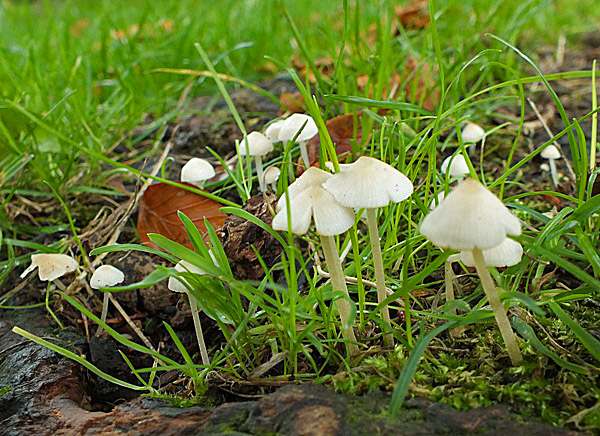
Many of the bonnet fungi are difficult to identify with
confidence, and Atheniella flavoalba (until recently known as Mycena flavoalba) is quite a challenging one because there are several other pallid little bonnet mushrooms that grow in the same kinds of habitats. Macroscopic and microscopic characters should therefore be checked when species level identity of small pale bonnet-shaped mushrooms is required.
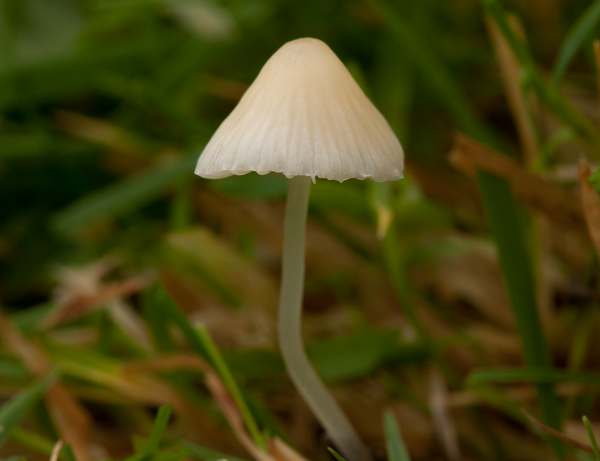
Distribution
This little mushroom is fairly common in all parts of Britain and Ireland; it is also found throughout most of mainland Europe and in many parts of North America.
Taxonomic history
When in 1838 Elias Magnus Fries described this bonnet mushroom, he called it Agaricus galopus (at a time when gilled fungi were generally placed into the genus Agaricus, since largely redistributed across many other newer genera).
French mycologist Lucien Quélet transferred this species to the genus Mycena in 1872, but now its generally accepted scientific name is Atheniella flavoalba, following a 2012 publication by Canadian mycologists Redhead, Moncalvo, Vilgalys and Perry.
Valid synonyms of Atheniella flavoalba include Mycena flavoalba (Fr.) Quel., Agaricus flavoalbus Fr., Hemimycena flavoalba (Fr.) Singer, and Marasmiellus flavoalbus (Fr.) Singer.
In the more distant past this little bonnet mushroom was widely referred to by the scientific name Mycena luteoalba; however, that name was invalid because it had already been allocated to another bonnet mushroom, very rare in Britain, originally described in 1788 by James Bolton as Agaricus luteoalbus and in 1821 transferred to the genus Mycena by Samuel Frederick Gray, making it Mycena luteoalba (Bolton) Gray.
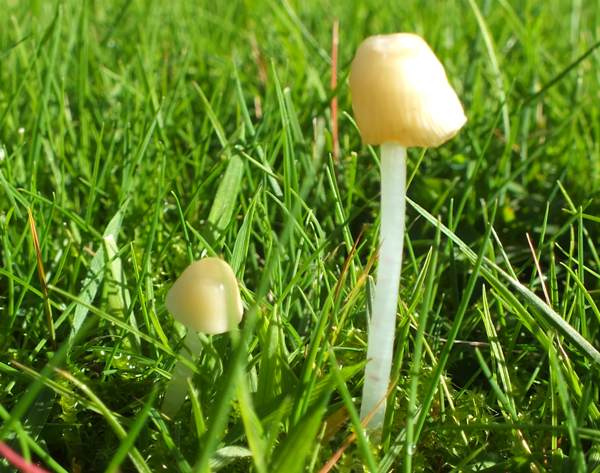
Etymology
The specific epithet flavoalba comes from the prefix flavo- meaning yellow and -alba meaning white, and so this is a reference to the yellowish white (ivory!) colour of the caps of these bonnet mushrooms.
Identification guide
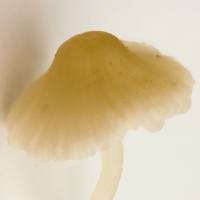 |
Cap
1 to 2cm in diameter when fully mature, the
caps are conical or campanulate, eventually becoming flattened with an umbo; lined almost to the cap centre; margin toothed; white at the margin and yellowish towards the centre. The thin cap flesh is whitish. |
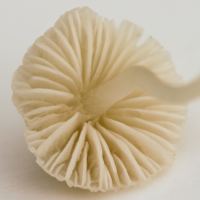 |
Gills
Adnexed, usually with a short decurrent tooth, the
fairly distant gills are white at first, becoming cream when fully mature.
Stem
Cylindrical, 2.5-6cm long and 1.5-2.5mm in diameter, the brittle stems are whitish to pale yellow, very finely pruinose (powdery) towards the apex, then smooth and usually with the base densely covered with coarse white fibrils. The stem flesh is whitish. |
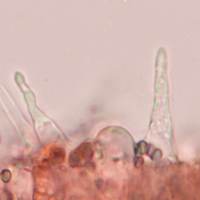 |
Cheilocystidia
Cheilocystidia (cystidia on the gill edges) are lageniform (flask shaped) or fusiform (spindle shaped), 45-80μm tall and 9-14μm across; smooth except towards the narrow apex where they are sometimes covered in an amorphous jelly-like material. Pleurocystidia (cystidia on the gill faces) are similar to the cheilocystodia.
Basidia
The slender-clavate basidia, 24-30μm tall and x 5.5-6.5μm in diameter at the widest point, are four-spored; clamps are present at the bases. |
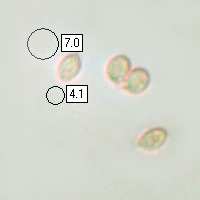 |
Spores
Ellipsoidal to cylindrical, smooth, 7-9 x 3.5-4µm; inamyloid.
Spore print
White. |
Odour/taste |
Odour and taste very faint, of radish. |
Habitat & Ecological role |
Saprobic; on mossy lawns, in dune slacks, on grassy woodland edges and sometimes in grassy woodland clearings. (In Scandinavia the Ivory Bonnet is mainly a woodland species.) |
Season |
August to late November in Britain and Ireland. |
Similar species |
There are numerous bell-shaped fungi in the Mycena genus, several of which are macroscopically quite similar to the Ivory Bonnet and few of them are easily separated in the field. |
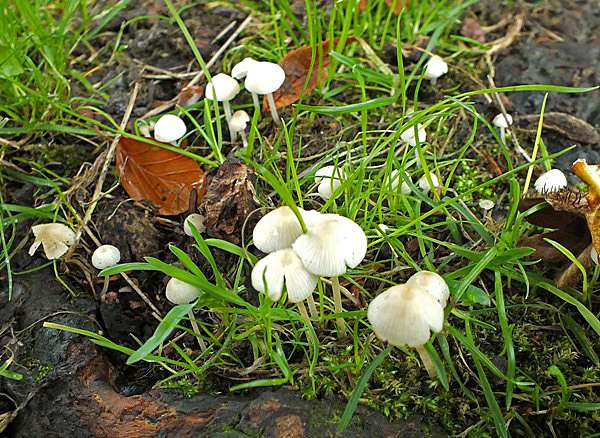
Culinary Notes
Although recorded in some field guides as edible, these little mushrooms are far too insubstantial to be of any serious culinary interest.
Reference Sources
Fascinated by Fungi, 2nd Edition, Pat O'Reilly 2016, reprinted by Coch-y-bonddu Books in 2022.
Penny Cullington, (Oct. 2013). British Mycenas - Brief Descriptions.
Giovanni Robich, (2003). Mycena d'Europa; Associazione Micologica Bresadola ; Vicenza : Fondazione Centro Studi Micologici.
British Mycological Society, English Names for Fungi
Dictionary of the Fungi; Paul M. Kirk, Paul F. Cannon, David W. Minter and J. A. Stalpers; CABI, 2008
Taxonomic history and synonym information on these pages is drawn from many sources but in particular from the British Mycological Society's GB Checklist of Fungi.
Acknowledgements
This page includes pictures kindly contributed by David Kelly.
Top of page...
Fascinated by Fungi. Back by popular demand, Pat O'Reilly's best-selling 450-page hardback book is available now. The latest second edition was republished with a sparkling new cover design in September 2022 by Coch-y-Bonddu Books. Full details and copies are available from the publisher's online bookshop...